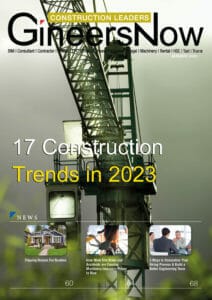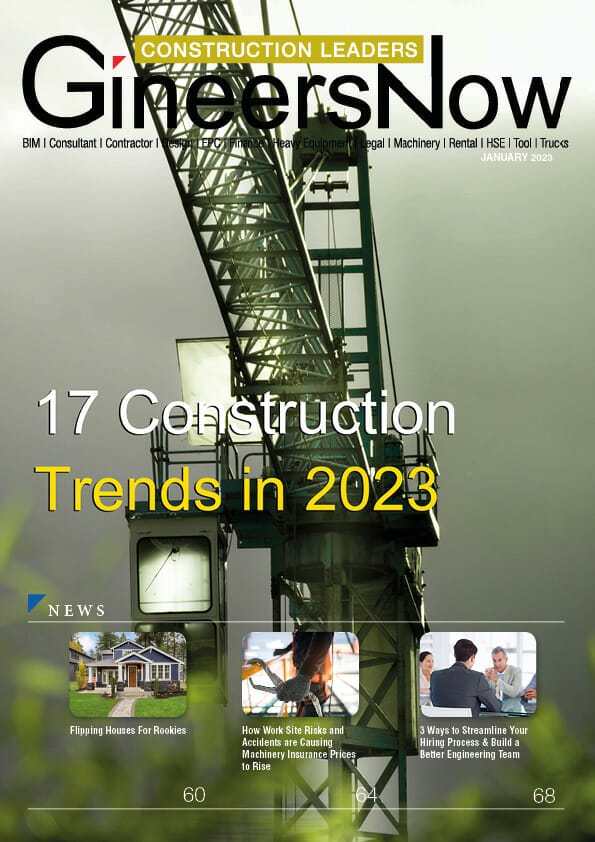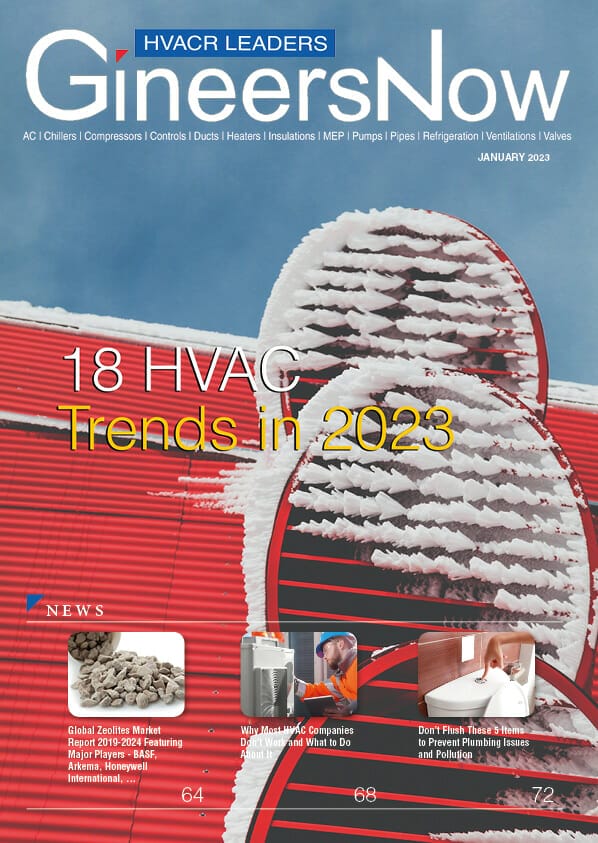The construction industry is constantly changing and evolving. As we continue to move forward into the future, it’s important to stay up-to-date on the latest trends and innovations in construction. In this article, we’ll be looking at the top construction trends in 2023 that are expected to take shape in 2023. From developments in green building materials to the emergence of digital technology, these construction trends will shape the industry for years to come.
Here are the 17 construction trends in 2023:
1. Advances in Automation
As the construction industry seeks to make projects more efficient and cost-effective, automation will be one of the most important construction trends in 2023. Automation offers a range of advantages, including improved accuracy and faster project delivery. It also increases safety onsite by providing remote control over hazardous tasks and reducing manual labor.
The use of automated robots in construction is becoming increasingly popular as companies look for ways to reduce costs while still maintaining high standards of quality. Automated robots can perform various tasks, such as welding, drilling, riveting, painting, and surveying. They are often more precise than manual labor and can work around the clock, leading to increased productivity and reduced costs overall. Additionally, robotic systems often offer greater flexibility with their adaptability to changing requirements onsite or offsite during the course of a project’s lifespan.
As the construction industry evolves, new trends are emerging and shaping how we think about buildings. From the materials used to build structures to the technology that helps manage construction projects, there is a lot of change and innovation happening in this space. With the future of construction on everyone’s minds, it’s no surprise that people are wondering what construction trends in 2023 will be – what new materials will become available? How will technology shape these projects?
What is automation in construction?
Automation in construction is a hot topic for the upcoming years, and it’s important to understand the concept before diving into specific trends. Automation simply refers to using machines, computers, and other technologies to complete tasks that humans would otherwise do manually. This can include anything from using robots on a building site to using software programs that can estimate materials needed or create 3D models of an entire project. Automation is changing how construction projects are planned, managed, and completed, allowing for streamlined processes that reduce errors and improve efficiency.
By 2023, automation will be more widely used in the construction industry, with remote-controlled vehicles being employed on building sites to easily collect information or transport tools and materials around a worksite. Other uses of automation could include drones being used as surveying tools or trucks being operated autonomously on highways near building sites.
2. Prefabricated Buildings and Modularization
2023 is set to be a major turning point in the engineering and construction industries as the demand for prefabricated buildings and modularization increases. Prefabrication has revolutionized the industry, allowing projects to be completed faster than ever before while reducing costs associated with traditional construction methods. Modularization is also on the rise as companies seek ways to streamline their processes by creating structures that can be broken up into separate parts for easy assembly and transportation.
The construction industry is constantly evolving, and as we move into the future, it is important to stay ahead of emerging trends. With 2023, now is a great time to take a look at what trends are on the horizon for the year.
What are prefabricated buildings?
In the world of construction, prefabricated buildings are becoming increasingly popular. Prefabricated buildings are assembled from parts that are manufactured off-site in a factory and then transported to their final destination for assembly. The process is cost-effective and efficient and yields high-quality results. As the demand for quick, affordable construction continues to rise, prefabricated construction is expected to be one of the most prominent construction trends in 2023.
The process of creating a prefabricated building typically involves three stages: production, transportation, and assembly. Individual elements such as walls and windows are manufactured off-site using specialized machinery based on predetermined designs during production. After they have been manufactured, they are shipped or transported to their destination, where they can be quickly assembled with minimal disruption to the local area.
3. Transformation of Materials
The engineering and construction industries are always changing to meet the demands of society. From new technology to redesigned materials, these industries are consistently innovating. In 2023, these trends will continue as architects, engineers, and construction professionals work together to transform building materials into efficient and sustainable options for their projects. One of the construction trends in 2023 is new building materials.
As we move towards a more eco-friendly future, sustainable architectural materials are becoming increasingly important. With this trend expected to grow in 2023, modern construction projects can expect to see a shift towards using renewable resources like bamboo and recycled plastics for structural components such as walls or roofing. Additionally, there will be an increased focus on using energy-efficient insulation products to help regulate temperatures within buildings while reducing energy consumption.
What are building materials in construction?
Building materials are necessary components in any construction project. As architects, contractors, and developers plan for new projects, they must consider the types of materials they need to construct a safe and reliable structure. This article, construction trends in 2023, will explore some of the most common building materials used today and how these materials could evolve over time.
Modern builders have many options when it comes to selecting building materials. Wood is one of the oldest choices that are still commonly used due to its strength and durability. Steel is another popular material because it can be manipulated into almost any shape or size needed for a project while also providing superior resistance to corrosion. Other popular materials include concrete, masonry blocks, brick, glass panels, aluminum cladding, insulation boards, and various plastics such as PVC pipe or polyethylene sheeting.
4. Building Information Modeling (BIM)
Construction Trends in 2023: Building Information Modeling (BIM) is set to revolutionize the engineering and construction industry. With its ability to allow users to create, visualize and analyze building projects in a 3D environment, BIM is quickly becoming an indispensable tool for architects, engineers, and contractors. It provides better coordination between design teams and allows them to accurately plan out every step of a project before proceeding with the actual construction process.
The increasing use of technology, such as cloud computing and mobile devices, has further expanded the capabilities of Building Information Modeling (BIM). This enables companies to access files from any location at any time, thus streamlining communication among all stakeholders involved in a project. Furthermore, BIM allows multiple parties to collaborate on a project simultaneously by providing visibility into every aspect of building design.
What is Building Information Modeling?
Building Information Modeling (BIM) is an emerging technology that has the potential to revolutionize the construction industry. BIM is a digital representation of a facility’s physical and functional characteristics, allowing for detailed planning and management of building projects. It provides data-rich 3D models throughout the entire life cycle of a project, from design through construction to operations, allowing all stakeholders to collaborate and make informed decisions.
In 2023, it is expected that much of the construction industry will adopt BIM as part of their standard practices. This technology can provide significant cost savings by reducing labor costs and increasing efficiency in design processes. Additionally, it allows for more accurate scheduling forecasting and enhanced collaboration between teams across different disciplines. As a result, contractors can deliver projects on schedule with fewer errors or delays due to a lack of coordination between teams.
5. Innovations in Design
With new developments in engineering and construction trends in 2023 promises to be a year of amazing innovation. As the industry strives to create innovative and sustainable structures, there is a growing focus on using “smart” materials such as carbon fiber composites, advanced ceramics, and wooden structures with engineered wood products. These materials offer increased strength and durability while reducing the costs associated with traditional construction methods. In addition to utilizing these types of materials, architects and builders are exploring more efficient ways to utilize existing resources through projects emphasizing reuse and recycling.
The concept of using technology to improve how buildings are designed is becoming increasingly popular as well. Architects are incorporating virtual reality systems into their designs to give clients an immersive experience viewing potential real estate properties. Some of the most innovative designs come from architects and designers utilizing new methods to improve upon existing properties. Green roofs have become increasingly popular in recent years as these structures help reduce urban heat islands, improve air quality, and even provide more space for urban agriculture.
6. Sustainable Practices
As construction projects become more complex and globalized, staying up-to-date on engineering and construction trends in 2023 is more important than ever. Sustainable practices are expected to be at the forefront of major engineering and construction trends in 2023.
In particular, using green building materials such as recycled steel, bamboo, and solar panels will become much more commonplace in buildings around the world. Architects and engineers will also continue to focus on developing renewable energy sources such as wind turbines, hydroelectric dams, geothermal systems, and biomass power plants that can help reduce emissions while providing reliable electricity. Additionally, increased use of prefabricated structures will lead faster to build times with less wastage from traditional methods.
What is sustainability in construction?
As we plan for the industry’s future, sustainability in construction is an important concept. To understand how sustainability will impact construction trends in 2023, it is essential to gain insight into what sustainability actually means.
Construction sustainability focuses on reducing environmental impacts while increasing performance and efficiency. This includes everything from improving energy efficiency, using renewable and recycled materials, reducing water consumption, and minimizing waste. It also involves designing more resilient buildings against natural disasters such as flooding, earthquakes, or hurricanes. Other social components related to sustainability include ensuring safe working conditions for employees and creating healthy living spaces for occupants.
As we look toward 2023, there is no doubt that sustainability-focused building practices will continue to be a major part of the construction industry’s growth and development.
7. Smart Construction Technology
The engineering and construction industry is rapidly changing as technology continues to develop. Automation, robotics, and artificial intelligence are revolutionizing how new projects are designed and built. As we look ahead to 2023, there is a growing focus on smart construction technology — an industry trend that has the potential to significantly improve efficiency, safety, cost, and sustainability in the construction process. One of the construction trends in 2023 is smart construction.
Smart construction technology utilizes advanced data collection tools such as sensors or drones to collect real-time information about a given project site. This data can then be used by engineers and contractors to inform decisions throughout a project’s life cycle, from planning to completion.
What is smart technology?
Smart technology has revolutionized the construction industry and is set to continue to do so in 2023. Smart technology means incorporating sensors, robotics, and automation into various aspects of construction projects. This allows for improved efficiency, accuracy, and safety, resulting in cost savings for businesses operating within this sector.
Smart technology is used in areas such as data analytics which helps inform decision-makers on the progress of projects. Automation tools are also employed to reduce waste and increase productivity. In addition, safety features such as automated warning systems can be installed to prevent accidents and improve working environments. Furthermore, smart building materials can be used to construct more environmentally friendly buildings with lower carbon footprints than traditional methods.
8. New Workforce Practices
The engineering and construction industries are constantly changing, and 2023 will be no exception. We can expect to see new workforce practices focusing on creating a more productive environment for those in the industry. In response to the pandemic of 2020-2021, remote work has become commonplace, and this is one trend that is likely to continue into 2023, especially in China and other high-risk countries. Companies may also begin exploring virtual reality technologies as a way to manage projects from afar without sacrificing quality or communication.
Additionally, companies will look for ways to make their processes more efficient by utilizing advanced automation tools like artificial intelligence (AI) software. AI can help streamline operations such as material orders, workforce scheduling, and project planning. This would lead to improved accuracy in project forecasting and reduced costs through better resource utilization. Finally, we can anticipate shifts towards green construction initiatives with the aim of reducing carbon emissions associated with construction projects.
What are workforce practices in construction?
Construction is one of the most important sectors in any economy and a rapidly changing field. The trends in construction are constantly shifting and adapting to new technology and consumer demands. One of the construction trends in 2023 is new workforce practices.
Workforce practices in construction are based on the idea that efficient labor is critical for successful projects. They focus on creating an efficient work environment where each person’s skill set is utilized to their fullest potential. Practices such as job rotation, cross-training, hiring people with specialized skill sets, and providing adequate tools for workers have become increasingly popular over the past few years as companies strive to maximize efficiency while keeping costs low.
9. Impact on Costs and Efficiency
With the ever-changing engineering and construction trends in 2023, it is important to stay up to date with the latest innovations that are impacting costs and efficiency. In 2023, we can expect to see a wide range of technological advancements that will revolutionize how projects are managed and completed. By leveraging these tools and strategies, companies can improve their workflow, reduce costs, and increase efficiency.
One of the biggest changes expected in 2023 is an increased focus on automation technologies such as robotics and artificial intelligence (AI). Automation will allow for faster construction processes, improved accuracy in scheduling tasks, greater overall safety measures onsite, and reduced labor costs associated with projects. Furthermore, AI systems can identify potential risks before they arise or suggest better solutions than human experts.
Why cost and efficiency are important in construction?
Construction is a complex and ever-evolving industry, always striving to make the most efficient use of resources while keeping costs low. As we look ahead to 2023 and beyond, cost efficiency and optimization will remain at the forefront of construction trends in 2023.
Recent technological advances have made it easier than ever before for construction companies to leverage data-driven insights to reduce project costs and increase operational efficiency. For example, automation tools can help track time spent on projects more accurately, leading to better budgeting decisions. Additionally, digital platforms such as Building Information Modeling (BIM) can be used to improve communication between contractors and streamline workflows. By leveraging these powerful digital tools, businesses can optimize their operations while minimizing project costs.
10. Emerging Building Techniques
The engineering and construction industries are always in a state of flux as new building techniques continuously emerge. As we look to the future, it is important to consider how these changes will shape how buildings are constructed. By 2023, certain trends in engineering and construction will become increasingly popular, allowing for more efficient and sustainable building practices. One of the construction trends in 2023 is novel building techniques.
One trend that is expected to take off by 2023 is prefabrication. This method involves constructing large sections of a building off-site before assembling them on-site. The result is a much faster construction timeline with fewer materials needed compared to traditional methods. In addition, prefabrication can be conducted in controlled environments, which helps reduce the risk of workplace safety issues or weather delays during the process.
Another emerging trend in engineering and construction by 2023 is 3D printing technology. This type of printing allows for the creation of complex geometries, creating a lighter and stronger product than traditional materials. 3D printing also has the potential to dramatically cut down on manufacturing costs as it eliminates the need for excess production materials.
Why are new building techniques important in construction?
The construction industry is constantly changing and evolving, and new building techniques are a major factor in this transformation. In the next four years, construction trends in 2023 will continue to be shaped by technological advances, materials, and design. As we look toward 2023 and beyond, it is important to understand why new building techniques are so vital for the future of the industry.
New building techniques help improve safety for workers onsite and those living and working in or near the structures being built. Many of these advancements allow for better protection from environmental hazards such as extreme temperatures or destructive weather conditions. New methods can also reduce waste caused by traditional construction processes, making them better for our planet and our wallets! Furthermore, newer techniques can often involve lower labor costs due to increased automation, leading to increased efficiency gains.
11. Smart Materials & Technologies
As engineering and construction trends in 2023 continue to advance rapidly, the construction industry is embracing the use of smart materials and technologies to create sustainable and efficient structures. By 2023, many unique advancements will be commonplace in the industry as smart materials such as self-healing concrete, shape memory alloys, and superhydrophobic coatings become more widely used.
Smart technologies such as automated production systems, Internet of Things (IoT) sensors, 3D printing processes, and artificial intelligence applications are also anticipated to revolutionize how projects are created.
The use of these new materials and technology will allow for improved safety protocols during construction projects while reducing waste material costs.
Additionally, their utilization could reduce time consumption for design and maintenance tasks.
What are smart materials in the construction industry?
Smart materials are a growing trend in the construction industry, and they’re expected to become more important in the years ahead. Smart materials are those that can respond to environmental changes or stimuli from their surroundings and adjust accordingly. As technology advances, so will these types of materials, leading to more innovative advances for the construction sector.
In 2023 and beyond, smart materials will have an even bigger role in the industry. Common applications include self-cleaning surfaces, temperature control systems, and automated window shading. With this technology, buildings can be designed to reduce energy consumption while providing a higher level of comfort for occupants. Developers also stand to benefit from cost savings due to reduced maintenance needs on these technologically advanced systems.
Additionally, smart material technologies may help address sustainability issues such as water conservation by automatically controlling irrigation systems based on local climate conditions.
12. Advancements in Robotics
The engineering and construction industry is rapidly changing with the introduction of new technologies. By 2023, robotics will have made a significant impact on the efficiency and safety of engineering and construction projects around the world. Companies are increasingly investing in automation technology to take advantage of its cost-effectiveness and improved productivity. One of the construction trends in 2023 is advancements in robotics.
Robotic systems for engineering and construction tasks require sophisticated sensors, 3D vision systems, control algorithms, motion planning techniques, artificial intelligence (AI) techniques, navigation systems, vibration control devices, and motion hardware. These technologies allow for higher accuracy levels in site survey operations using robotic land surveying tools or automated robots that can detect obstacles or damage in structures.
Robotics also allows for faster construction processes as autonomous machines can be used to build walls or deliver materials autonomously without human intervention.
The impact of robotics in relation to the construction industry
The construction industry is constantly changing, and robotics are increasingly becoming a part of this transformation. In the next several years, robotics will significantly impact how we construct buildings and other structures. As technology progresses, automation and artificial intelligence advancements will help make the construction process more efficient and cost-effective.
Robots can be used for various tasks within a construction project, from prepping materials to welding components together. These machines reduce labor costs which helps to lower expenses for both developers and contractors. Additionally, robots can perform certain tasks more quickly than humans, saving time and money. Robots can also operate during weather conditions, keeping projects on track despite adverse weather conditions or delays caused by human labor shortages.
In effect, robotization will likely revolutionize how we build things in 2023.
13. Augmented Reality: Visualization & Planning
Engineering and construction trends in 2023 are ever-changing, with technological advances and new materials popping up each year. One of the biggest trends to watch for in 2023 is the use of augmented reality (AR), which has already been making strides in the industry. Augmented reality presents a new way for engineers and contractors to create, visualize, and plan projects quickly and efficiently.
The use of augmented reality brings a more immersive experience to engineering construction. With AR, design teams can virtually walk through a project site before breaking ground or plan out an entire engineering project from start to finish on their computer screens. These 3D models allow for better visualization of end products, giving designers more accurate feedback about how their plans will look in real-life scenarios.
What is augmented reality?
Augmented reality (AR) technology is revolutionizing various industries, including construction. Augmented reality integrates digital information with the user’s environment in real-time, providing enhanced interactive visualizations and experiences. AR has the potential to improve construction projects by increasing accuracy, decreasing costs, and enabling remote collaboration among teams. In this article, we’ll explore what augmented reality is and how it could impact the construction industry in 2023.
In the simplest terms, augmented reality overlays computer-generated images onto a person’s view of the world around them. It can be experienced through various devices, such as smartphones or tablets. This technology captures data from external sources like GPS data, video streams, or 3D models to create interactive features that are injected into physical environments.
14. Cloud Computing: Streamlined Processes
As the engineering and construction industry continues to evolve, we have seen an increase in technological trends that promise to streamline processes. One such technology is cloud computing, which has been widely adopted in many engineering and construction sectors.
Cloud computing allows for quick access to data via a secure network, simplifying communication between various stakeholders, including developers, contractors, and clients. This technology also enables efficient collaboration by making information available at all times while reducing manual processes that are prone to errors.
The ability of cloud computing to facilitate faster decision-making processes is one of its main advantages when it comes to engineering and construction trends in 2023; architects can view 3D models online from anywhere in the world without needing expensive equipment or software installation. Furthermore, it provides real-time insights into job progress and cost savings which helps project managers stay on top of developments more effectively.
The construction industry is continuing to evolve and has become more efficient in its methods. Introducing new techniques, products, and materials has greatly improved the safety and speed of construction projects. As technology continues to advance, so will construction trends in 2023. This year, we can expect to see more use of green building materials, increased digitization, automation of certain processes, and a focus on sustainability. All these new trends will ultimately help to improve quality standards for the industry as a whole.
What is cloud computing?
Cloud computing is an increasingly popular technology transforming how businesses operate.
Cloud computing is a form of distributed computing where data and applications are stored on remote servers instead of local devices. This means that users can access these services from any device with an internet connection without downloading any software or hardware.
The major benefit of using cloud computing is that businesses can scale their resources quickly as needed, allowing them to meet customer demand more efficiently. Cloud-based software solutions also make it easier for businesses to collaborate and share information securely with employees, customers, and partners anywhere in the world.
15. Safety and Security
The engineering and construction industry is always changing and adapting to the world around it. In 2023, safety and security will be two of the most important trends in this sector. One of the construction trends in 2023 is safety and security.
In the wake of a global pandemic, safety has become more of a priority for construction workers, who must adhere to new protocols like social distancing and wearing masks at all times onsite. To ensure compliance with these rules, many companies will implement high-tech surveillance systems that monitor workers’ movements and alert supervisors if something seems amiss. Employers may also invest in installing devices or software that track how long employees spend on certain tasks to better manage job performance.
Security measures have also been stepped up in recent years due to the rise in cyber threats targeting construction companies’ servers or networks.
16. Energy Efficiency
The engineering and construction industries regularly adapt new technologies to increase energy efficiency. In 2023, the industry is projected to take a major leap forward in its efforts toward sustainability. One of the construction trends in 2023 is energy efficiency
Some of the top trends that engineers and builders should look out for include enhanced building materials, renewable energy sources, automated workflow processes, and smart technology implementation. Building materials such as insulated concrete forms are becoming more popular as an effective way to reduce thermal loss from buildings by up to 40%.
Additionally, renewable energies such as solar panels or wind turbines are now being integrated into new constructions. Automated workflow processes can be used to streamline operations and minimize wasted energy through optimized equipment utilization.
Finally, smart technology can be utilized as sensors or control systems that monitor internal building conditions while adjusting lighting levels or temperatures accordingly.
17. Offsite fabrication
One of the construction trends in 2023 is offsite fabrication. The engineering and construction industries are constantly evolving, developing new trends and technologies to meet the demands of an ever-changing world. In 2023, one of the most prominent trends will be an offsite fabrication. This trend is based on the idea that building components can be made in a factory setting before being transported to their intended location for assembly, resulting in time and cost savings.
Offsite fabrication has been used by engineers and builders since the 1950s; however, technological advancements have allowed it to become more efficient and cost-effective in recent years. For example, 3D printing has enabled components to be produced with greater accuracy than ever before. Furthermore, technology such as virtual reality allows for design elements to be tested prior to production – ensuring quality control from start to finish. Additionally, robotics systems enable automated manufacturing processes that further reduce production’s labor costs.
Takeaway: Construction Trends in 2023
In conclusion, the construction industry will experience significant growth in 2023. New innovations and technologies, such as 3D printing and automated machines, have the potential to revolutionize the way projects are completed. Additionally, increased demand for eco-friendly materials will drive innovation and spur market competition. As a result, 2023 is poised to be an exciting year for the construction industry, with opportunities abound for businesses that can capitalize on these trends.
Read GineersNow Construction Magazine for FREE
Editor’s Note
The construction industry is constantly changing and growing with the emergence of new technologies and materials. As the industry progresses, predictions about future for construction trends are made. This article will discuss some of these predictions for what to expect when it comes to construction trends in 2023. It will explore technological and materials developments, environmental standards, and safety regulations. It will also look at potential growth areas in the coming years.
Construction slowdown in 2023 due to the looming global financial crisis
The construction world faces an uncertain future due to a looming global financial crisis in 2023. Experts predict that the construction industry will suffer a significant slowdown, with projects being delayed or canceled altogether. This could have a devastating effect on the entire sector and the broader economy.
The current state of international politics and economic instability has led many governments and businesses to put off their investments in large-scale projects for fear of further losses. Furthermore, rising cost pressures from labor, materials, and regulations make it difficult for firms to remain competitive in this increasingly challenging environment.
While some believe that the construction industry will be able to weather this storm with minimal disruption, others maintain that it’s likely to experience some serious challenges over the next few years.
Why is high inflation rate slowing down the construction industry?
The growth of the construction sector is threatened by a high rate of inflation. Inflation affects the construction industry in several ways:
First, when prices rise faster than wages, consumers have less money to spend on building projects. This reduces demand for construction services and reduces total output. Second, when inflation is too high, it can make investments in construction projects more expensive. As a result, businesses may be reluctant to invest in new building projects or expansions of existing ones.
Finally, a high inflation rate makes it difficult for contractors to estimate their costs and profits on future contracts accurately. Without accurate cost projections, they are less likely to bid on projects that may prove unprofitable due to unexpected inflation-related price increases.



























